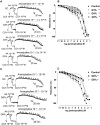Intensity of swimming exercise influences tracheal reactivity in rats
- PMID: 26497013
- PMCID: PMC5137269
- DOI: 10.1540/jsmr.51.70
Intensity of swimming exercise influences tracheal reactivity in rats
Abstract
Studies that evaluate the mechanisms for increased airway responsiveness are very sparse, although there are reports of exercise-induced bronchospasm. Therefore, we have evaluated the tracheal reactivity and the rate of lipid peroxidation after different intensities of swimming exercise in rats. Thus, male Wistar rats (age 8 weeks; 250-300 g) underwent a forced swimming exercise for 1h whilst carrying attached loads of 3, 4, 5, 6 and 8% of their body weight (groups G3, G4, G5, G6 and G8, respectively; n=5 each). Immediately after the test, the trachea of each rat was removed and suspended in an organ bath to evaluate contractile and relaxant responses. The rate of lipid peroxidation was estimated by measuring malondialdehyde levels. According to a one-way ANOVA, all trained groups showed a significant decrease in the relaxation induced by aminophylline (10(-12)-10(-1) M) (pD2=3.1, 3.2, 3.3, 3.3 and 3.2, respectively for G3, G4, G5, G6 and G8) compared to the control group (pD2=4.6) and the Emax values of G5, G6, G8 groups were reduced by 94.2, 88.0 and 77.0%, respectively. Additionally, all trained groups showed a significant increase in contraction induced by carbachol (10(-9)-10 (-3) M) (pD2=6.0, 6.5, 6.5, 7.2 and 7.3, respectively for G3, G4, G5, G6 and G8) compared to the control group (pD2=5.7). Lipid peroxidation levels of G3, G4 and G5 were similar in both the trachea and lung, however G6 and G8 presented an increased peroxidation in the trachea. In conclusion, a single bout of swimming exercise acutely altered tracheal responsiveness in an intensity-related manner and the elevation in lipid peroxidation indicates a degree of oxidative stress involvement.
Figures




Similar articles
-
Intensity of swimming exercise influences aortic reactivity in rats.Braz J Med Biol Res. 2015 Nov;48(11):996-1003. doi: 10.1590/1414-431X20154397. Epub 2015 Sep 18. Braz J Med Biol Res. 2015. PMID: 26397974 Free PMC article.
-
Anti-oxidative systems in rat skeletal muscle after acute physical exercise.Appl Physiol Nutr Metab. 2007 Apr;32(2):190-6. doi: 10.1139/h06-078. Appl Physiol Nutr Metab. 2007. PMID: 17486159
-
Relationship between in vivo airway reactivity and in vitro responsiveness of tracheal smooth muscle in inbred rats.Respiration. 1988;54 Suppl 1:108-13. doi: 10.1159/000195486. Respiration. 1988. PMID: 3068743
-
Protective effects of long term dietary restriction on swimming exercise-induced oxidative stress in the liver, heart and kidney of rat.Cell Biochem Funct. 2007 Mar-Apr;25(2):129-37. doi: 10.1002/cbf.1279. Cell Biochem Funct. 2007. PMID: 16143963
-
L-carnitine does not exert any in vitro relaxant effect in Guinea pig trachea, lung parenchyma and human bronchial tissue.Exp Lung Res. 2002 Sep;28(6):485-92. doi: 10.1080/01902140290096746. Exp Lung Res. 2002. PMID: 12217214
Cited by
-
Modeling exercise using optogenetically contractible Drosophila larvae.BMC Genomics. 2022 Aug 30;23(1):623. doi: 10.1186/s12864-022-08845-6. BMC Genomics. 2022. PMID: 36042416 Free PMC article.
-
Exercise-Induced Regulation of Redox Status in Cardiovascular Diseases: The Role of Exercise Training and Detraining.Antioxidants (Basel). 2019 Dec 23;9(1):13. doi: 10.3390/antiox9010013. Antioxidants (Basel). 2019. PMID: 31877965 Free PMC article. Review.
-
Supplementation With Spirulina platensis Improves Tracheal Reactivity in Wistar Rats by Modulating Inflammation and Oxidative Stress.Front Pharmacol. 2022 May 31;13:826649. doi: 10.3389/fphar.2022.826649. eCollection 2022. Front Pharmacol. 2022. PMID: 35712706 Free PMC article.
References
Publication types
MeSH terms
Substances
LinkOut - more resources
Full Text Sources
Other Literature Sources
Research Materials
Miscellaneous

